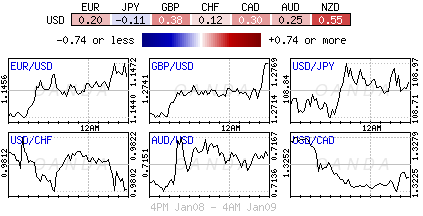Wednesday January 9: Five things the markets are talking about
Global equities are well supported for a third consecutive session as the U.S and China have found some common ground on trade.
Note: Both countries agreed to extend trade talks in Beijing for an unscheduled third-day.
Despite both negotiating teams being unable to reach an all-encompassing trade deal over the past 48-hours, the world’s two largest economies appear to have progressed towards bridging the hostile divide that has been able to unsettle capital markets over the past 12-months.
These positive signs have given investors the confidence to own risk once again, and has led the U.S dollar to dip against G10 currency pairs and Treasury yields to back up a tad before this afternoons release of the Fed’s December minutes (02:00 pm EDT).
The minutes are unlikely to have much impact on the ‘big’ dollar, given Fed chair Powell’s comments last week, where he indicated that U.S policy makers are prepared to shift the stance of its policy “significantly” if necessary.
On tap: Bank of Canada (BoC) monetary policy meeting (10:00 am EDT) – Governor Poloz is expected to hold rates steady (+1.75%), though pricing in the Overnight Index Swaps (OIS) market suggests there is a +17% possibility that the bank could reverse its most recent hike.
1. Stocks are a delight
With the U.S and China finding some common ground in their trade talks has made owning stocks more appealing.
In Japan, equities rallied for a third-day as signs of progress in Sino-U.S trade talks improved confidence, offsetting weakness in chip-related stocks. Both the Nikkei and the broader Topix advanced +1.1%.
Down-under, Aussie stocks rallied to a two-month high on trade optimism. The S&P/ASX 200 index closed up +1%, building on Tuesday’s gain of +0.7%. In S. Korea, the Kospi index posted its biggest daily percentage gain in two-months, closing +1.95% higher.
In China, these positive trade talks helped push the blue-chip CSI300 index up +1.0% and the Shanghai Composite Index up +0.7%. In Hong Kong, at the close of trade, the Hang Seng index was up +2.3%, while the Hang Seng China Enterprises index jumped +2.2%.
In Europe, with risk being well supported, regional bourses are trading higher – the DAX and the French CAC are the most notable.
U.S stocks are set to open in the ‘black’ (+0.35%).
Indices: Stoxx600 +0.76% at 348.50, FTSE +0.77% at 6,914.25, DAX +0.91% at 10,901.79, CAC-40 +1.09% at 4,825.08, IBEX-35 +0.15% at 8,861.15, FTSE MIB +1.14% at 19,220.50, SMI +0.36% 8,652.50, S&P 500 Futures +0.35%

2. Oil rises over +1% on Sino-U.S trade talks, gold lower
Oil prices have extended their gains from Tuesday’s session on hopes that Washington and Beijing may soon resolve their trade disputes.
Brent crude futures are up +69c, or +1.2%, while U.S West Texas Intermediate (WTI) oil futures are at +$50.42 per barrel, up +64c, or +1.3% from yesterday’s close.
Note: Both benchmarks gained +2% in yesterday’s session.
Aside from global trade optimism, crude oil prices have been receiving support from supply cuts that started at the end of last year by OPEC+.
Theses cuts are intended to rein in a supply overhang, caused mostly by U.S crude oil output – EIA data shows U.S output surged by around +2M bpd in 2018, to a record +11.7M bpd.
Dealers are expected to take their cue from today’s official U.S fuel storage data from the EIA (10:30 am EDT).
Ahead of the U.S open, gold prices have edged lower on stronger risk sentiment. Spot gold is down -0.3% at +$1,282.75 per ounce, while U.S gold futures are -0.2% lower at +$1,283.8 per ounce.

3. Bank of Canada (BoC) rate decision in focus
CAD’s OIS curve (overnight index swap) currently paints a ‘dovish’ view of Canadian interest rates (+1.75%). Nevertheless, there are a few dealers who do not prescribe to a ‘no-rate’ change decision by the BoC later this morning; in fact, they are looking for +25 bps hike.
Even without pricing in a hike today, the CAD (C$1.3240) remains the best-performing G10 currency over the past week – the loonie has found support from higher oil prices and a positive surprise from Canadian PMI data. If Governor Poloz gets the urge to tighten matters, USD/CAD could see itself take on C$1.3080 rather quickly.
Elsewhere, the Fed releases the minutes of its Dec. 18-19 meeting this afternoon (2 pm EST). It should provide more details about how policy makers viewed the risks to economic growth when they raised interest rates during a period of heightened market volatility.
They voted unanimously to hike fed-funds to a range between +2.25% and +2.5% at the meeting, their fourth increase of the year. They also made a significant change to their policy forecast by projecting two rate increases in 2019, down from the three they anticipated in September, despite modest changes to their growth expectations.

4. EUR trapped in a range
For now, EUR/USD (€1.1450) is trapped within a range as weak German and eurozone economic data will not allow the ‘single’ currency to rally and close above €1.15 despite the ‘big’ dollar weakness. However, if the Sino-US trade talks do happen to show some concrete progress, then the EUR bulls should expect that key resistance of €1.15 to give way rather quickly.
GBP/USD is higher by +0.2% at £1.2735 area as PM May seeks EU assurances on the backstop provision. Last night, the UK government lost a vote on funding a “no-deal” Brexit – this certainly complicates matters for PM May as Parliament tries to stop a “no-deal” Brexit.
Note: The U.K parliament is due to vote on the Brexit withdrawal bill on Jan 15, until then, the pound remains driven by any Brexit developments.
USD/JPY (¥108.90) is higher for a fourth consecutive session as investor risk appetite improves on speculation that U.S-China is making progress in their trade talks.

5. German trade balance
Data this morning showed that German exports declined in November, supporting market fears that trade tensions are impeding Germany’s economic upswing.
Exports from the eurozone’s largest economy fell -0.4% on the month to +€110.6B in November, while imports dropped -1.6% to +€91.6B from October. The adjusted trade surplus amounted to +€19.0B in November, surpassing a market forecast of +€18.0B.
Note: The German economy contracted in Q3 2018, for the first-time in three-years, knocked mostly by weaker exports.
The drop in exports coincides with other downbeat data released this week – German new manufacturing orders fell -1% on the month in November, more than the -0.4% decline that the street was expecting.

Content is for general information purposes only. It is not investment advice or a solution to buy or sell securities. Opinions are the authors; not necessarily that of OANDA Business Information & Services, Inc. or any of its affiliates, subsidiaries, officers or directors. If you would like to reproduce or redistribute any of the content found on MarketPulse, an award winning forex, commodities and global indices analysis and news site service produced by OANDA Business Information & Services, Inc., please access the RSS feed or contact us at info@marketpulse.com. Visit https://www.marketpulse.com/ to find out more about the beat of the global markets. © 2023 OANDA Business Information & Services Inc.



